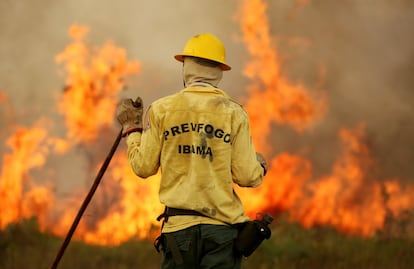Heat deaths in South America have increased 160% in the last 20 years
‘The Lancet’ has for the first time published a report on the relationship between health and climate change in the region


“In South American countries the number of heat-related deaths has increased by 160% between the periods of 2017-2021, and 2000-2004.” This was one of the most shocking figures provided by Doctor Stella M. Hartinger during the media presentation of the 2022 South America Report of The Lancet Countdown on health and climate change. “The adverse health effects of climate change are accelerating and disproportionately affecting the most vulnerable populations in South America. This trend will only continue if prompt action is not taken,” warned the director of the project, which, for the first time in its history, has published a report focused exclusively on the region.
Conducted by 21 institutions and authored by 28 researchers who compiled information from 12 countries (Argentina, Bolivia, Brazil, Colombia, Chile, Ecuador, Guyana, Paraguay, Peru, Uruguay, Venezuela, and Suriname), the report, published on Tuesday, collates 25 indicators that not only warn of the impacts of climate change are having on people’s health, but also maps out the benefits of mitigating the crisis as well as ways to make our health systems more resilient to what is coming. It also sounds a note of alarm over several issues.

Heatwaves and malnutrition
In South America, excessive temperatures are an issue of survival. Over the last 10 years, heatwaves have posed a greater danger to children aged under one and adults aged over 65, the report notes. This translates into an increase in heat-related deaths since 2000, which has trended upwards in countries such as Brazil, Argentina, Colombia and Venezuela, the most affected nations in terms of total attributable deaths. However, the countries where this indicator has increased most since the turn of the century are Ecuador (1,477%), Guyana (328%), and Chile (225%). Working in the heat has become so problematic that the potential losses associated with the reduction in labor productivity in 2021 were equivalent to $22 billion.
The South American population also has a very high or extremely high exposure to forest fires. In nine of the 12 countries analyzed for the report, this exposure increased by seven days between 2018-2021, compared to the baseline (1996-2005).
Equally, the researchers state, climate scenarios for transmissible diseases such as dengue are becoming more favorable, with the climate suitability for dengue increasing by 35.3% in the period between 2012-2021, compared to the 1951-1960 baseline. “Compounding the increase in dengue risk posed by climate changes, temperate Southern Cone countries are highly vulnerable to severe dengue outcomes, mainly driven by rapid urbanization. Argentina and Uruguay experienced increased vulnerability between 1990 and 2019,” the report notes.
In terms of food security, the report states that the climate crisis will make having access to a healthy, balanced and affordable diet all the more complex. During 2021, for example, the duration of the growth season for key crops such as wheat, corn, soybeans and rice trended downward, “exposing potential threats to crop yields.”

Red meat and air quality
Although South America is only responsible for 6% of global greenhouse gas (GHG) emissions, reducing them would bring health benefits for the its residents. Thirty-nine percent of the region’s emissions come from the energy sector and the burning of fossil fuels is turning into deadly air pollution. In the 12 countries analyzed, exposure to particulate matter 2.5 (PM2.5) — particles so minute they are up to twenty times smaller in diameter than a hair — caused a combined 37,000 deaths in 2020 alone, with Chile and Peru the worst-affected countries.
The paradox is that South American governments continue to subsidize fossil fuels, to a total value equivalent to 10.5% of health spending in the entire region. At the top of this toxic list is Venezuela — which awards subsidies equal to 85% of the national health budget — followed by Ecuador (29.2%), Bolivia (23.5%) and Argentina.
A similar relationship exists in terms of red meat consumption. While 24% of South America’s GHG emissions come from land use changes, in which livestock plays a major role, 23% of all deaths attributable to unbalanced diets in the region have been linked to high consumption of red meat, processed meat and dairy products. “Minimizing red meat intake as per dietary guidelines would therefore not only help avert these deaths, but simultaneously lead to reduction in GHG emissions related to livestock rearing and the associated agricultural practices,” the report notes.
Climate change and health systems
The report stresses that beyond the impacts of climate change, the need to prepare ourselves for the new world that climate change will create is paramount, particularly with regard to public health systems. In South America, only 10% of health funding, equivalent to $36 million, was designated for climate change-related health adaptation in the region in 2021. Furthermore, The Lancet researchers note, “only Brazil has developed an HNAP [Health National Adaptation Plan] up to 2021, while other countries — Argentina, Colombia, Chile, and Peru — report having them ready but not submitted or under development.”
“It is clear that South America must act now to protect the health of its populations from the increasing health risks posed by climate change. Governments must allocate funds to protect the health of local populations and take steps to transition to zero carbon emissions,” says Dr. Hartinger. In South America, the relationship between climate change and health is the precise point where vulnerabilities can be enhanced or reduced.
Sign up for our weekly newsletter to get more English-language news coverage from EL PAÍS USA Edition
Tu suscripción se está usando en otro dispositivo
¿Quieres añadir otro usuario a tu suscripción?
Si continúas leyendo en este dispositivo, no se podrá leer en el otro.
FlechaTu suscripción se está usando en otro dispositivo y solo puedes acceder a EL PAÍS desde un dispositivo a la vez.
Si quieres compartir tu cuenta, cambia tu suscripción a la modalidad Premium, así podrás añadir otro usuario. Cada uno accederá con su propia cuenta de email, lo que os permitirá personalizar vuestra experiencia en EL PAÍS.
¿Tienes una suscripción de empresa? Accede aquí para contratar más cuentas.
En el caso de no saber quién está usando tu cuenta, te recomendamos cambiar tu contraseña aquí.
Si decides continuar compartiendo tu cuenta, este mensaje se mostrará en tu dispositivo y en el de la otra persona que está usando tu cuenta de forma indefinida, afectando a tu experiencia de lectura. Puedes consultar aquí los términos y condiciones de la suscripción digital.
More information
Archived In
Últimas noticias
Most viewed
- Reinhard Genzel, Nobel laureate in physics: ‘One-minute videos will never give you the truth’
- Oona Chaplin: ‘I told James Cameron that I was living in a treehouse and starting a permaculture project with a friend’
- Pablo Escobar’s hippos: A serious environmental problem, 40 years on
- Why we lost the habit of sleeping in two segments and how that changed our sense of time
- Chevy Chase, the beloved comedian who was a monster off camera: ‘Not everyone hated him, just the people who’ve worked with him’










































